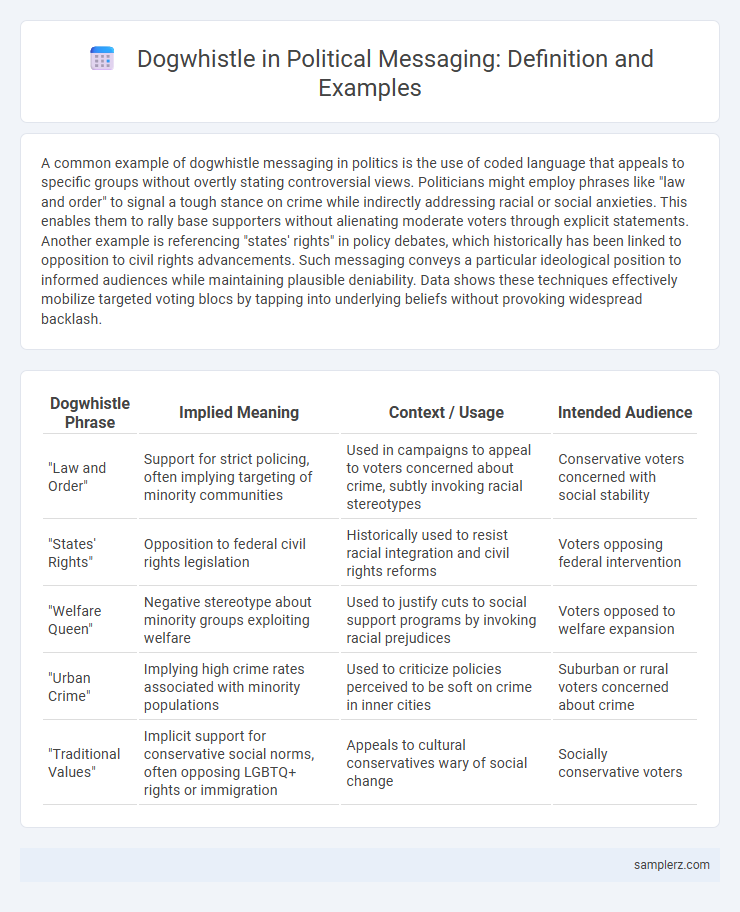A common example of dogwhistle messaging in politics is the use of coded language that appeals to specific groups without overtly stating controversial views. Politicians might employ phrases like "law and order" to signal a tough stance on crime while indirectly addressing racial or social anxieties. This enables them to rally base supporters without alienating moderate voters through explicit statements. Another example is referencing "states' rights" in policy debates, which historically has been linked to opposition to civil rights advancements. Such messaging conveys a particular ideological position to informed audiences while maintaining plausible deniability. Data shows these techniques effectively mobilize targeted voting blocs by tapping into underlying beliefs without provoking widespread backlash.
Table of Comparison
| Dogwhistle Phrase | Implied Meaning | Context / Usage | Intended Audience |
|---|---|---|---|
| "Law and Order" | Support for strict policing, often implying targeting of minority communities | Used in campaigns to appeal to voters concerned about crime, subtly invoking racial stereotypes | Conservative voters concerned with social stability |
| "States' Rights" | Opposition to federal civil rights legislation | Historically used to resist racial integration and civil rights reforms | Voters opposing federal intervention |
| "Welfare Queen" | Negative stereotype about minority groups exploiting welfare | Used to justify cuts to social support programs by invoking racial prejudices | Voters opposed to welfare expansion |
| "Urban Crime" | Implying high crime rates associated with minority populations | Used to criticize policies perceived to be soft on crime in inner cities | Suburban or rural voters concerned about crime |
| "Traditional Values" | Implicit support for conservative social norms, often opposing LGBTQ+ rights or immigration | Appeals to cultural conservatives wary of social change | Socially conservative voters |
Decoding Dogwhistles: Hidden Messages in Political Rhetoric
Decoding dogwhistles in political rhetoric reveals subtle cues that convey controversial or divisive ideas without explicit statements. These coded messages often exploit cultural or social anxieties to rally specific voter bases while maintaining plausible deniability. Recognizing linguistic patterns, such as euphemisms or ambiguous terms, is essential to critically analyze political communication strategies.
Historical Examples of Dogwhistle Politics
Historical examples of dogwhistle politics include Richard Nixon's 1968 "Southern Strategy," which used coded language appealing to racial anxieties without explicit racism. Ronald Reagan's references to "welfare queens" in the 1980s subtly targeted African American communities while framing social welfare criticisms. George H.W. Bush's 1988 campaign ad "Willie Horton" exploited crime fears as a veiled racial warning to influence voter sentiment.
Dogwhistle Messaging in Election Campaigns
Dogwhistle messaging in election campaigns uses coded language to appeal to specific voter groups without overtly stating controversial positions, allowing candidates to signal support for sensitive issues while maintaining plausible deniability. These subtle cues often exploit racial, economic, or cultural anxieties, influencing public opinion without attracting widespread criticism. Analyzing slogans and speeches reveals how politicians embed dogwhistles to mobilize targeted demographics and shape electoral outcomes.
Racial Dogwhistles: Subtle Signals and Their Impact
Racial dogwhistles often involve coded language or euphemisms that appeal to specific biases without overtly expressing prejudice, such as referencing "law and order" to implicitly target minority communities. These subtle signals exploit shared cultural understandings, enabling politicians to mobilize support while maintaining plausible deniability. The impact of racial dogwhistles is profound, as they reinforce systemic discrimination and contribute to social polarization without triggering widespread condemnation.
Economic Policy and the Language of Dogwhistles
Economic policy messaging often employs dogwhistles by using terms like "welfare reform" or "job creators" that subtly signal ideological positions without explicit statements. These phrases resonate with specific audiences by implying critiques of government assistance or tax privileges for the wealthy while maintaining plausible deniability. Understanding the language of dogwhistles in economic discourse reveals how politicians manipulate public perception to influence policy support.
Immigration Debate: Dogwhistle Tactics in Discourse
In the immigration debate, politicians often use dogwhistle tactics by employing phrases like "protecting national identity" or "border security" to indirectly signal anti-immigrant sentiments without explicit statements. These coded messages resonate with certain voter bases while maintaining plausible deniability. The strategic use of such language shapes public perception and fuels polarization around immigration policies.
Media’s Role in Amplifying Dogwhistle Messages
Media outlets often amplify dogwhistle messages by repeatedly broadcasting coded language that appeals to specific ideological groups without overtly stating controversial views, increasing their reach and normalization. Through selective coverage and framing, media can inadvertently legitimize these subtle cues, embedding them into public discourse and influencing voter perceptions. This amplification leverages algorithms favoring provocative content, further entrenching divisive rhetoric within political messaging.
Case Study: Dogwhistles in Recent Political Speeches
In recent political speeches, dogwhistles have been strategically used to convey coded messages that resonate with specific voter bases without attracting broad condemnation. For example, phrases referencing "law and order" or "family values" often serve as subtle signals to constituents concerned about immigration or social change. These terms function as semantic triggers, allowing politicians to appeal to controversial viewpoints while maintaining plausible deniability.
Recognizing Dogwhistle Signals: Tools and Techniques
Recognizing dogwhistle signals in political messaging requires analyzing language patterns and contextual cues that convey coded meanings to specific audiences. Tools like sentiment analysis, keyword frequency tracking, and sociolinguistic profiling help identify phrases with dual interpretations that may mask underlying messages. Techniques such as cross-referencing historical usage and monitoring shifts in rhetoric intensity further enhance the detection of subtle dogwhistles designed to influence public opinion covertly.
Countering Dogwhistle Politics: Strategies for Awareness
Countering dogwhistle politics involves recognizing coded language that appeals to specific groups while remaining ambiguous to others. Strategies include media literacy education to help the public identify and decode subtle messages, and promoting transparent communication from political leaders. Monitoring and fact-checking organizations play a crucial role in exposing underlying intent behind seemingly benign statements.

example of dogwhistle in messaging Infographic
 samplerz.com
samplerz.com